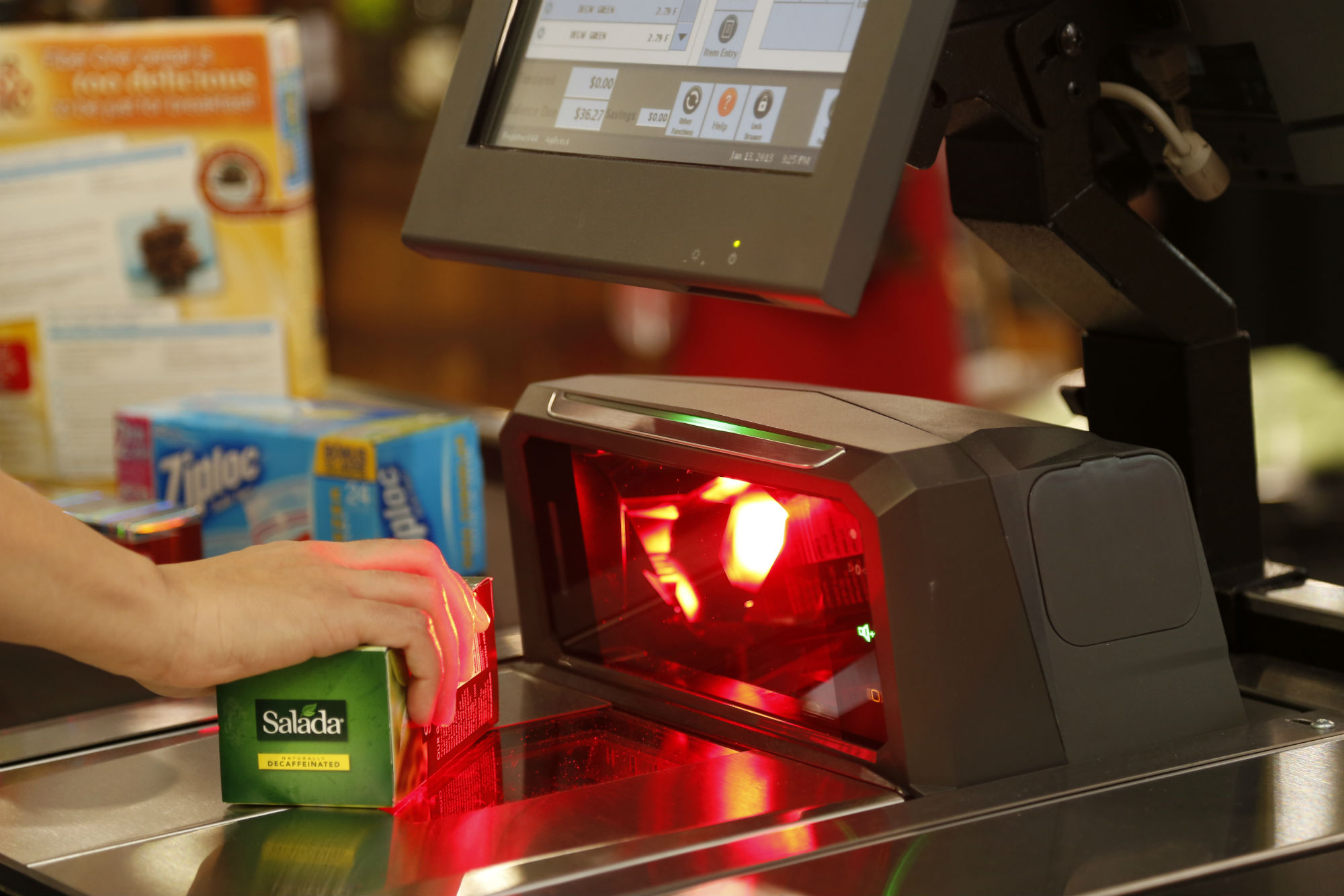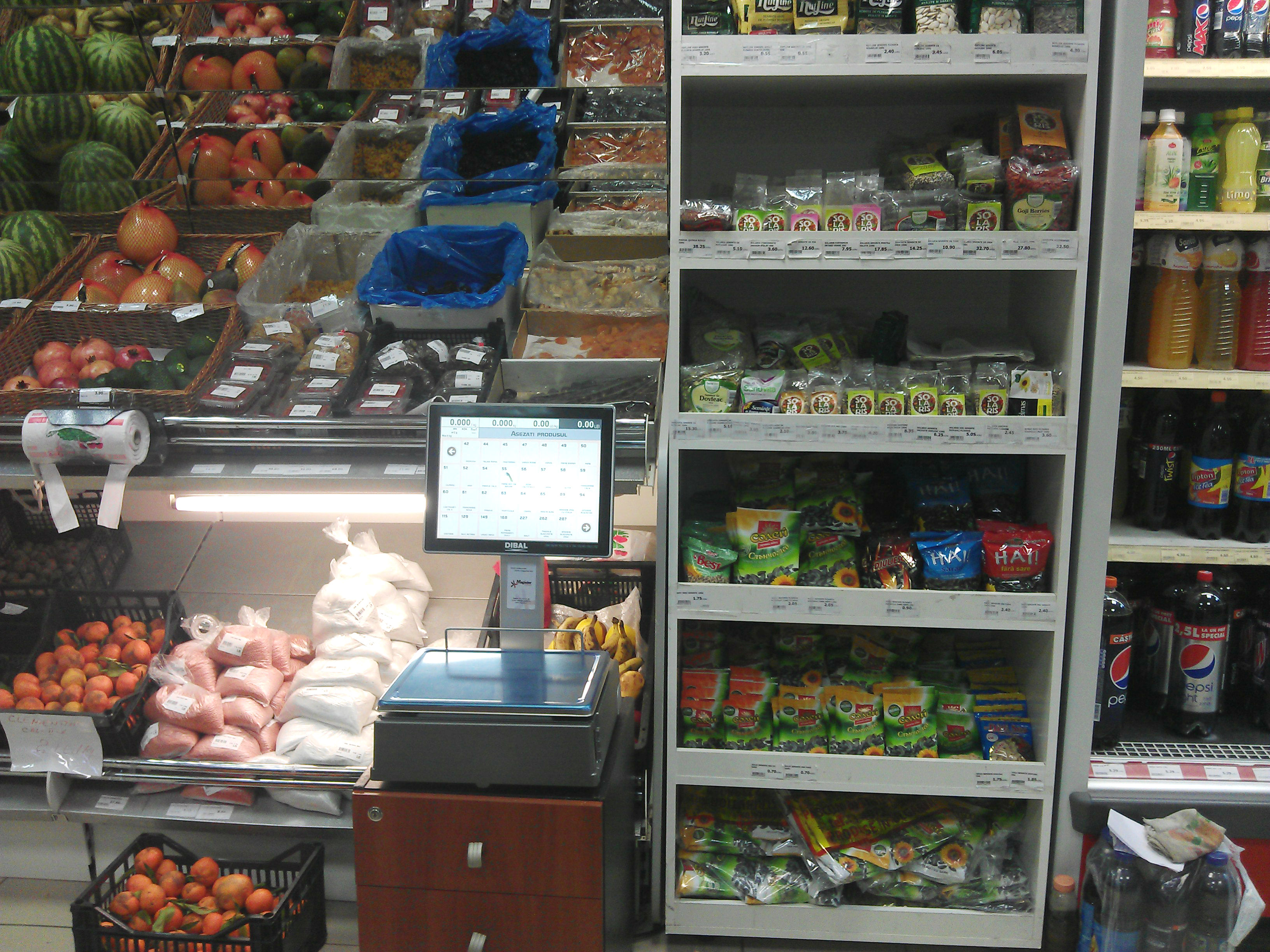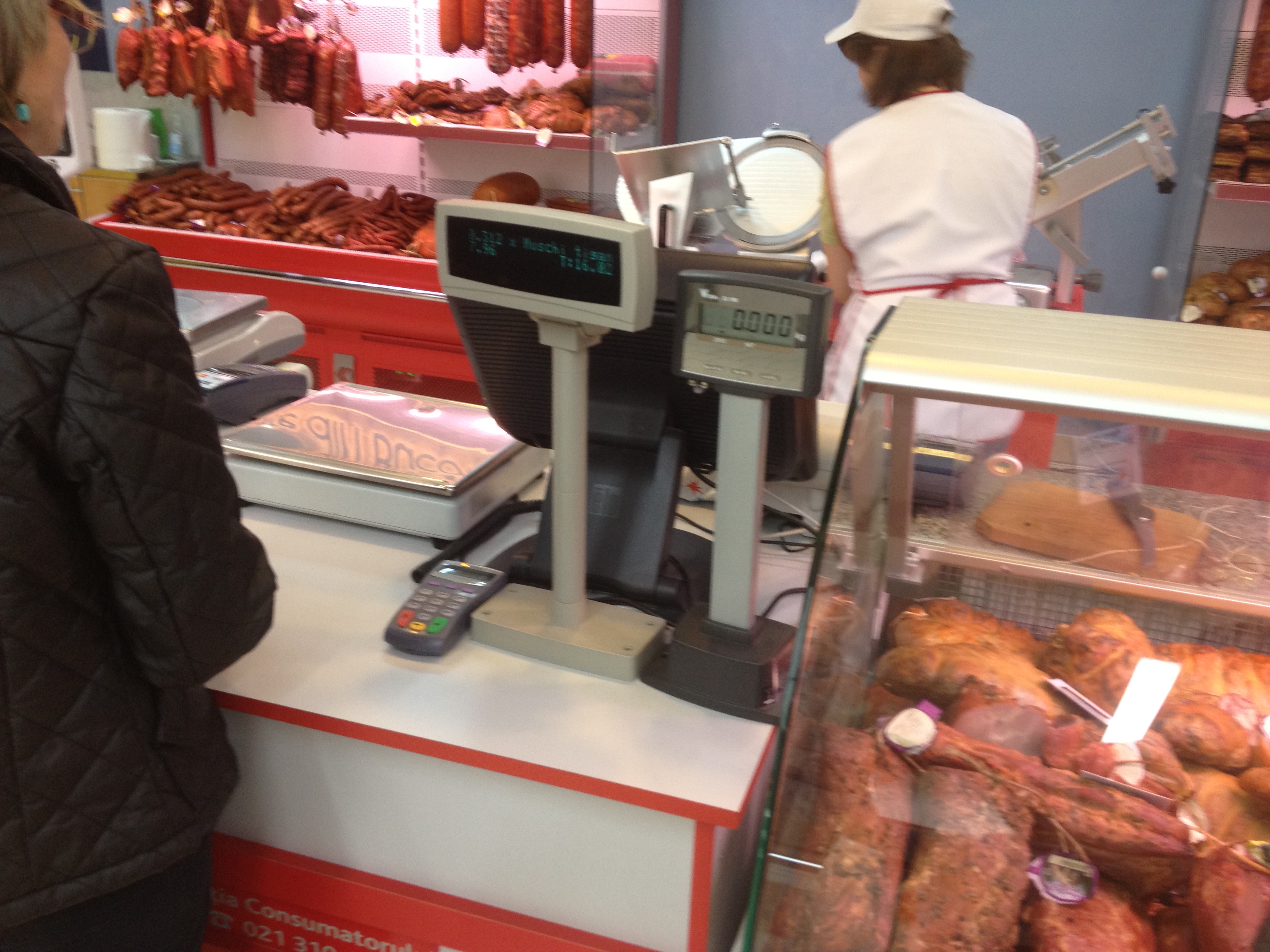From small to large: How to choose a trade scales for the store

Trade scales - an integral part of any grocery store. They are there a lot of different: checkout, self-service, a la carte, outboard, platform. We tell how to understand all this variety and choose the appropriate device depending on the format of the store.
To begin to clarify what we mean by the words "store format". Traditionally, food retail is divided by size:
- small non-chain stores format "at home";
- discounters (small chain stores format "at home");
- supermarkets;
- hypermarkets.
Although in fact the same action takes place there - the sale of goods to customers, the size of the store leaves an imprint. If the “at home” format can do with cheap checkout weights, then the hypermarket will have to equip several departments with different weights.
')
Non-network stores format "at home"
What is the online store format "at home"? This is a small point of sale where you run for the most necessary things - buy milk or bread. The range there is small. Previously, "at home" shops even managed without normal cash desks - but this stopped 54-FZ. However, there is no way to live without scales, as there is a weight product in the assortment: vegetables, fruits, sweets, cheese, sausage, meat.
When choosing weights for an "at home" store, you need to be guided by the retailer's budget - usually small - and throughput. Since the customer stream is small, there is little weight goods, and the sellers are able to remember the entire range, it is enough to buy the most usual check weights . You can choose cheap, Russian-made. Also in this segment there are models of Korean and Chinese vendors. Of course, cheap cash scales all consist of continuous restrictions: they have little memory, a segment display, which displays only the weight of the goods, sometimes the cost per kilogram and the price of the goods weighed. The functionality itself is also small: the device can be turned on, off or reset to zero.
But all these restrictions justify three things:
- such cash scales are inexpensive - the average price is 4-7 thousand rubles;
- they are compact and reliable;
- small shops of their functionality enough for the eyes.
However, if more customers come to the store, such budget checkout scales will not be enough. Usually they are equipped with mini and nano cash registers (they are also called “all in one”), which either have no COM ports, or there are not enough interfaces, since they are occupied by other equipment (for example, they are connected to a cash drawer). Therefore, it is advisable to buy scales with USB-connector, then they can be connected to the cash register and set up interaction with them using cash software. In this case, the retailer will be able to display a general check with the goods, without making additional manipulations. Such cash scales are more expensive: on average, 14-24 thousand rubles.
Separately among online stores of the "at home" format are retail outlets that use scanning technology - they have a hand-held scanner connected to the checkout. Usually such retailers prefer scales with check printing . This is sure to push-button scales with a minimum amount of memory and a small number of ports. They are able to memorize up to 2 thousand commodity items and information about products recommended for weighing. But their functionality is small - simple labels can print. In this case, most often we are talking about Russian scales with check printing. The cost of such devices ranges from 25-35 thousand rubles.
Discounters (small chain stores format "at home")
Discounters are also small shops of the “at home” format, but the difference is that they belong to a regional or federal network. Their owner has a bigger budget, and he can afford to spend money on trade automation. Therefore, in discounters, weight equipment and device models are more extensive and more expensive.
Here you can see the scales with check printing - which, as the name clearly indicates, besides weighing, also print labels. Usually they are placed in the departments of their own cooking. Alternatively, Dibal W-025 P or CAS CL3000.
Also in the discounters there are checkout scales - these are devices that are installed on the cash register. They are embedded in the general information network of the store, and, in addition to weighing, they also scan products. Checkpoint scales are of two types: single-plane and two-plane. The first is 1.5 times more compact than the second. For example, CAS PDS II (S), (H).
A small hint: if simple check weights are equipped with several ports, they can be used for two cash registers at once. This is a significant savings.
Supermarkets
Supermarkets are big stores with several cash registers. Let's start with the fact that they use two formats of work:
- equip a cash register with a cash register;
- they install self-service scales in the sales area so that customers themselves weigh goods, and only goods are scanned at the cash desks.
In the first case, retailers buy bioptic scanner scales, which cost from 80 thousand rubles. The reason for this is trivial: in a supermarket, the permeability is several times higher than in a discounter. Classic genre: NCR 7874-3020-909, Datalogic Magellan 8400 or newer models Zebra MP6000, Datalogic Magellan 9800, Dibal KS-400S (with scanner Honeywell Stratos MK2400).

In the second case, self-service scales help to increase the capacity of the store. Weighing at the checkout and searching for goods on the basis of - the most time-consuming part of the purchase. Therefore, it is excluded, replacing the check weigher scales self-service. Previously, these were push-button devices, either illustrations of goods or numbers accompanying them were placed on the keyboard — the same indicated the price tag of the products.
Today, supermarkets use self-service scales with a touch screen. The display can be placed more goods than the buttons, and look for them much easier - the search is carried out either by pictures or by numbers. In idle minutes, self-service scales can play multimedia content, telling, for example, about store promotions. There are self-service scales with touch screens within 100-130 thousand rubles.
However, the installation of self-service scales does not mean that the retailer completely refuses the scales at the checkout. Some, in the fight against re-grading and economic delinquency, use low-cost portions, which serve as checkweights at the cash desk. Option - CAS SW-2.
Here are tips on choosing self-service scales:
- It is advantageous to purchase self-service scales, which can use different types of labels without complex structural modifications (for example, changing the type of cassette).
- if you only need the function of weighing goods and a modern appearance of the device (for example, the presence of a touch screen), then it is not necessary to purchase PC self-service scales (full-featured computers with a weighing cell). It will be more profitable for a retailer to replace them with a touchscreen self-service system weights. Some models of similar devices are comparable in price to push-button self-service scales (in other words, they are much cheaper than PC scales).
- Take a closer look at the weights in which the replacement of a roll is made by a cassette method. It speeds up the replacement process. For example, a Dibal scale needs no more than six seconds to replace a cassette.

One more model of scales necessary in supermarkets is push-button scales with check printing, which are put in cheese, meat and fish departments. They remember a lot of commodity items and information about products (about 5-7 thousand items). Up to 20 store employees can work with them, with the scales analyzing the sales history of each seller. This helps to combat fraud with the participation of staff, as well as deal with customer complaints on a weighted product.
Button scales with check printing are equipped with several interfaces, including modules for connecting to scales by radio channels. This allows the use of various data transmission infrastructures to upload the product catalog to the device. If we talk about the cost of such scales, they can cost between 37-50 thousand rubles. Option: Mettler Toledo B-PLUS, CAS CL5000.
When choosing scales with check printing, you need to consider the following points:
- It is more functional to equip the display area of meat, cheese products and semi-finished products with scales with label printing, the keypad of which is located under the weighing platform lid. On top of them is only the display of the buyer. This allows you to quickly perform the procedure of weighing the goods, and this arrangement does not interfere with the interaction with customers.
- If you decide to equip a hypermarket with hanging scales with label printing, be sure to pay attention to whether they have a customer display (preferably at least 12 inches). Since it is at the level of the eyes of customers, you get the opportunity to convey to them advertising information by displaying multimedia content. It is important that there are already such scales on the market, which are no more expensive than ordinary suspended scales of advertised brands.

In the fish and meat departments of supermarkets you can see suspended scales - devices equipped with a special plate on which products are weighed. It is necessary so that no liquid gets into the electronic mechanism of the balance. Most often, the owners of supermarkets give preference to class “A” brand devices, their cost reaches 120 thousand rubles. We share tips on choosing suspended scales:
- If it is necessary to integrate the hanging scales into the general information network of the store, we recommend choosing models with Wi-Fi interface. In this case, they will be easier to move - this will not interfere with the wires leading to the device;
- It is advisable to purchase suspended scales, where label replacement is carried out using a cartridge (the tape does not need to be refilled each time). In this case, the store employee will not need to take off the gloves in order to replace the consumable material - since the label printing mechanisms do not touch. And this has a beneficial effect on their lifespan.

Hypermarkets
The hypermarket is a very, very large store with dozens of cash desks and a huge cross. They need only reliable devices that can withstand a significant load. Owners of such stores prefer functional weights: for example, PC self-service scales are not uncommon here - full-featured computers with weighing equipment that cost over 300 thousand rubles. It can be Dibal CS-1155 or CAS CL7000, as well as Mettler Toledo UC.
Also in the hypermarkets are:
- scales with check printing (they can be equipped with small multimedia displays of the buyer, and both color, and monochrome);
- portion scales (usually they are equipped with cafes or restaurants that are present on the territory of the hypermarket);
- scanner scales;
- suspended scales;
- scanner scales and platform scales embedded in self-service systems.
Tips for choosing portion scales:
- for baking departments, be sure to give preference to scales with a high degree of protection against dust: there are a lot of bulk ingredients in the product - flour, sugar powder, cinnamon, poppy seeds;
- it is also desirable that the scales be equipped with contactless keys - as an example reset to zero, taring.
- if you plan to use the portion scales as a check, it makes no sense to spend money on a device equipped with two displays. The second display is most often not used and simply turned to the wall.
A place display of perishable products hypermarkets equip industrial scales with the possibility of labeling and packaging. Since these devices are very expensive (cost from a million rubles), retailers are looking to save money. One of the ways is to purchase industrial scales, equipped with a semi-automatic etikerovschikom (even with its own infrastructure), and partially use the labor of the staff of the sales area. Then you do not have to spend money on additional components.
Source: https://habr.com/ru/post/349626/
All Articles